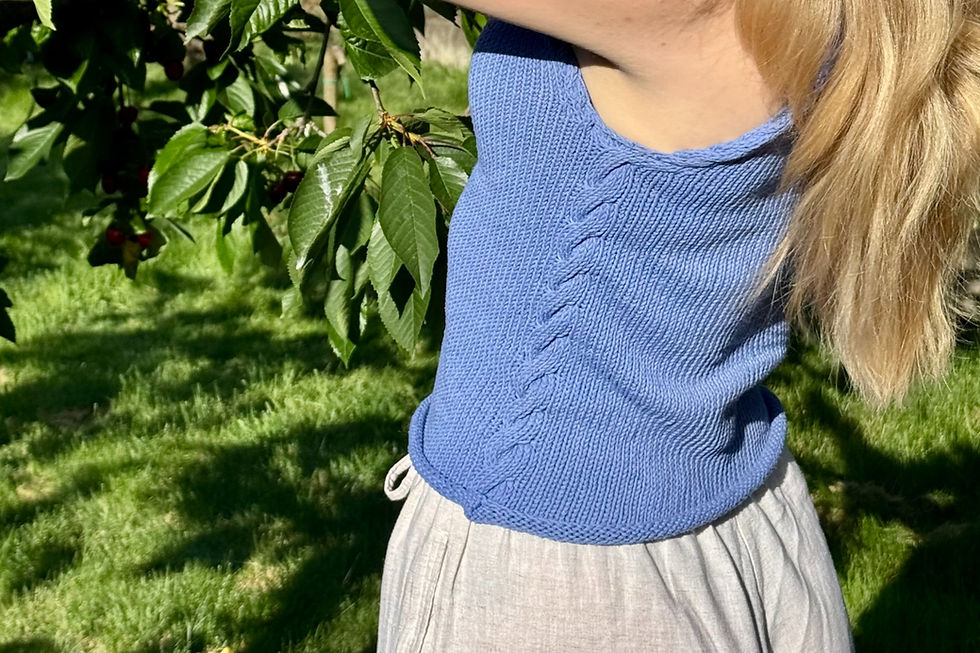How to Cable Front and Cable Back | Beginner’s Cabling Guide
- anouskaiap
- Jun 22
- 4 min read
Updated: Sep 23
Cables can look intimidating, but learning how to cable front and cable back is simpler than you think. In this beginner-friendly tutorial, I’ll walk you through cabling step by step, explain common abbreviations like C4F and C6B, and share my own tips for keeping your cables neat. Mastering these basics opens the door to endless possibilities, from classic Aran sweaters to modern textured knits.
This easy-to-follow guide will cover:

What Is Cabling in Knitting?
Cabling creates beautiful, twisting designs by manipulating the order in which the stitches are worked on your needles. While they look intricate and intimidating, most cables rely on a simple idea: moving knit stitches to be held at the front or back of your work temporarily.
Cable Abbreviations Explained (C4F, C6B, C8F)
Stitch & Row Count Matters
More often than not, cables are worked over an equal number of stitches, with an even number on each side of where the cable 'crosses' over.
For example:
A 4-stitch cable is a 2x2 cable. You work the stitches in 2 'groups' of 2.
A 6-stitch cable is a 3x3 cable. The 6 stitches are worked in 2 sets of 3.
So, an 8-stitch cable is 4x4, a 10-stitch cable is 5x5, and so on. Adjusting the total number of stitches across the cable notably changes its width and appearance.
When worked, cables are placed at intervals across a number of rows, impacting the 'roundness' and overall look of the cable. You might see a pattern that requires you to cable every 8 rows, every 23 rows, or every 6 rows. It just depends on what the knitwear designer is aiming for!
Cable Abbreviations in Patterns
Cabling in patterns is abbreviated with a C + a number + F or B. Let's break it down:
C stands for cable.
The Number is the total number of stitches the cable is worked over, e.g., C8 (this means you will work the cable in two groups of four stitches).
F stands for front, meaning the first group of stitches is moved to the front of your work.
B means back, so the first group of stitches is moved to the back of your work.
You'll encounter abbreviations such as C4F, C6B, C8F when knitting basic cable stitches.
Cable Front and Cable Back
How to Cable Front (Step-by-Step Tutorial)
Here's how to do a front cable:
Slip the first half of the stitches (e.g., 4 stitches for a C8F, 4x4 cable) onto a cable needle.
Drop the cable needle at the front of your work. If it slips, you can also hold it.
Knit the next group of stitches, 4 stitches in the case of a C8F, directly from the left-hand needle.
Pick your cable needle back up and leave/drop your left-hand needle.
Knit the stitches from the cable needle.
That’s it! You’ve just made a cable front. Now continue with the pattern as instructed.
How to Cable Back (Step-by-Step Tutorial)
Now for how to cable back:
Slip the first half of the stitches onto a cable needle. So, for a C6B, that would be 3 stitches.
Hold or drop the cable needle at the back of your work.
Knit the next group of stitches from the left-hand needle, so in this case, 3 stitches.
Take hold of your cable needle, allowing your left-hand needle to drop.
Knit the stitches from the cable needle.
Congrats! You now have a cable back, and you can carry on knitting the rest of the row as per the pattern.
Tips for Success When Cabling
Practice on a swatch first so you can see how the cables twist and learn the movements in your hands.
Use a cable needle that is U-shaped. This will prevent your stitches from sliding off when you drop those stitches to the front or back of the work.
Aim to keep your tension even when cabling. Cables naturally affect the tension in your fabric. As you knit them more often, you'll learn how cabling impacts tension and how to work around it. In my case, the purl after a cable is always larger and messier, so I've learned my fix!
TAKE A STEP BACK and look at what you're knitting. Honestly, there is no worse moment than looking at a column of cabling after hours of work and realizing one is twisting the other way! By stepping back and checking on your cabling regularly, you can fix mistakes before it's painfully late.
Learn which direction they go, meaning which direction the cable twists. A back cable will twist towards the right, while a front cable will twist leftwards. Learning this will be a lifesaver when you take the next step beyond basic cabling!
I use cables in nearly all of my patterns because they add texture and interest and of course are fun to knit! Once you have mastered cable front and cable back, you’ll be ready to take on more advanced cable projects in no time.
Practice Cables in My Patterns
Whether you’re knitting your first cabled hat or tackling a full sweater, mastering these two cable techniques (cable front and cable back) is your first stop on the way to more complex and rewarding projects.
If you’re curious about how I incorporate cables into my designs, check out The Olive Top: a perfect knit for adventurous beginners who are excited to take on some cables. So if you're ready, grab your needles and let the cabling journey begin!





















































Comments